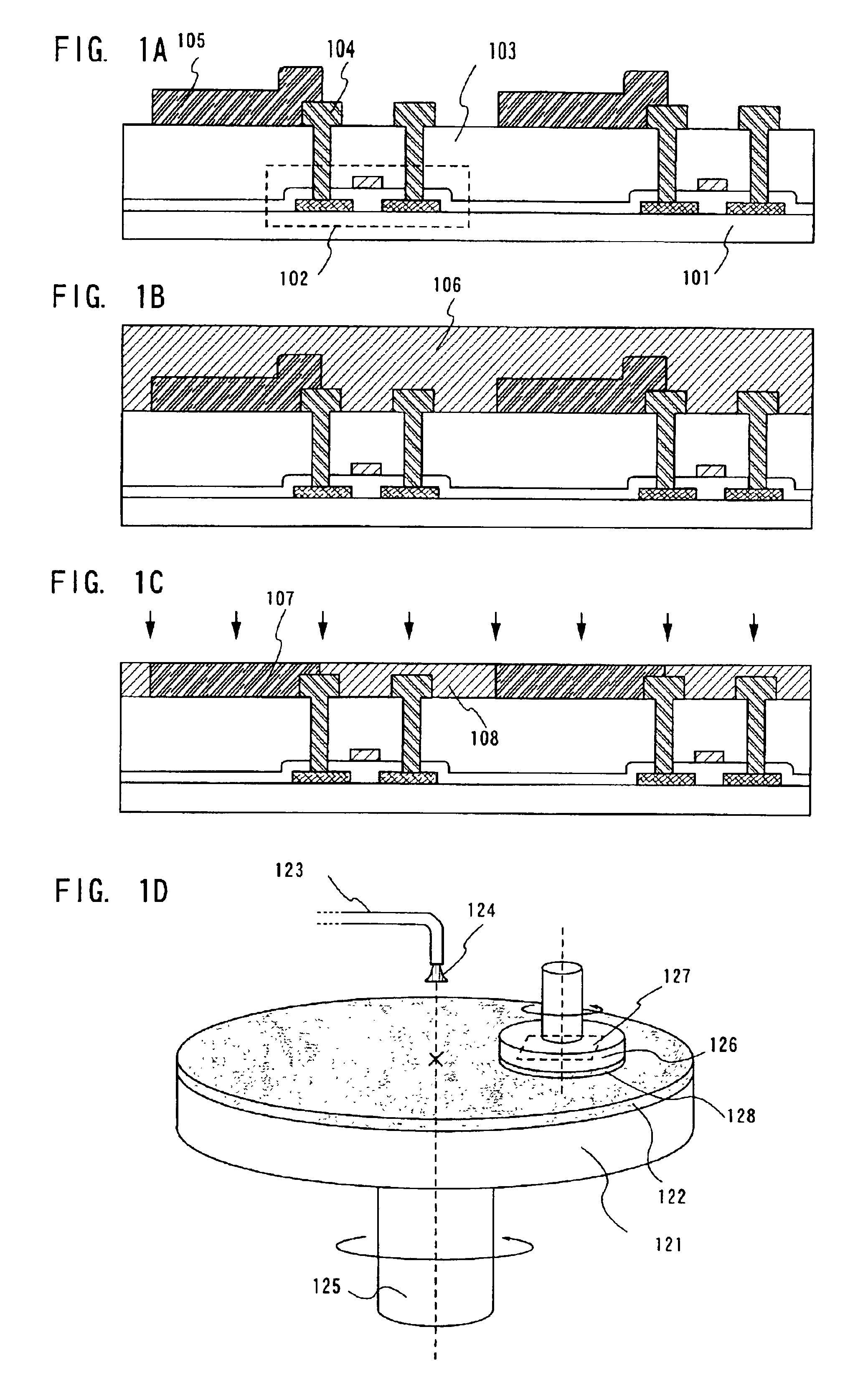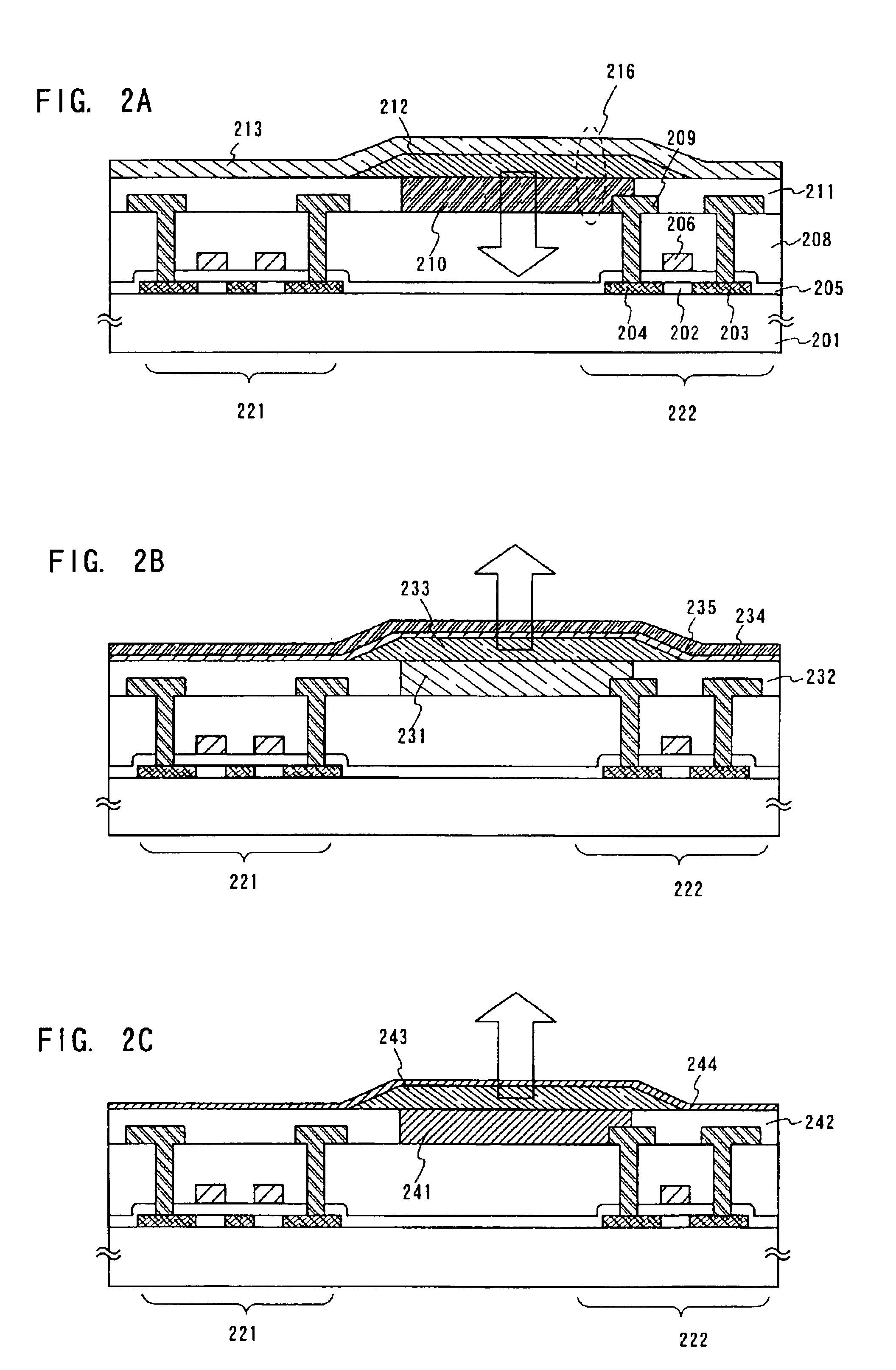Light emitting device and manufacturing method thereof
- Summary
- Abstract
- Description
- Claims
- Application Information
AI Technical Summary
Benefits of technology
Problems solved by technology
Method used
Image
Examples
embodiment mode 1
[Embodiment Mode 1]
[0114]A cross sectional structure of a pixel portion of a light emitting device formed as Embodiment Mode 1 of the present invention is shown in FIG. 2A.
[0115]Thin film transistors (TFTs) are formed on a substrate 201 in FIG. 2A. Note that there are shown here, an electric current control TFT 222 which is electrically connected to a first electrode 210 of a light emitting element 216, and which has a function for controlling electric current supplied to the light emitting element 216, and a switching TFT 221 for controlling a video signal applied to a to gate electrode of the electric current control TFT 222.
[0116]A glass substrate is used for the substrate 201 as a substrate having light transmittance here, and a quartz substrate may also be used. Further, active layer of each TFT is provided with at least a channel forming region 202, a source region 203, and a drain region 204.
[0117]Further, a gate electrode 206 is formed covering a gate insulating film 205, an...
embodiment mode 2
[Embodiment Mode 2]
[0122]The following describe a sectional structure of a pixel portion of a light emitting device as Embodiment Mode 2 of the present invention, referring to FIG. 2B. The structure is formed is the same as in Embodiment Mode 1 except that the current-controlling TFT 222 is formed by an n-channel type. Thus, the structure formed after that the wiring 209 is formed is described.
[0123]On the first interlayer insulating film 208 is formed a first electrode 231 connected electrically to the source region or the drain region of the current-controlling TFT 222 by the wiring 209. In Embodiment Mode 2, the first electrode 231 is formed to be a cathode.
[0124]The organic compound layer 233 is formed on the first electrode 231, therefore, it is allowable to form a barrier layer 234 by a sputtering for preventing the damage of the organic compound layer 233 when the second electrode 235 is formed. For the barrier layer 234, copper phthalocyanine (Cu-Pc), gold, platinum or the l...
embodiment mode 3
[Embodiment Mode 3]
[0128]The following describe a sectional structure of a pixel portion of a light emitting device as Embodiment Mode 3 of the present invention with reference to FIG. 2C. The current-controlling TFT 222 is formed to be a p-channel type as same as in the Embodiment Mode 1. Thus, the structure formed after that the wiring 209 is formed is described.
[0129]On the first interlayer insulating film 208 is formed a first electrode 241 connected electrically to the source region or the drain region of the current-controlling TFT 222 by the wiring 209. In Embodiment Mode 3, the first electrode 241 is formed to be an anode. For forming the first electrode 241, a material having a large work function and functioning as an anode is used. Further, conductive materials having light-shielding effect and a high reflectivity are used to form the first electrode 241.
[0130]An organic compound layer 243 is deposited on the first electrode 241. A light emitting elements made of the seco...
PUM
| Property | Measurement | Unit |
|---|---|---|
| Thickness | aaaaa | aaaaa |
| Electrical conductivity | aaaaa | aaaaa |
| Structure | aaaaa | aaaaa |
Abstract
Description
Claims
Application Information
 Login to View More
Login to View More - R&D
- Intellectual Property
- Life Sciences
- Materials
- Tech Scout
- Unparalleled Data Quality
- Higher Quality Content
- 60% Fewer Hallucinations
Browse by: Latest US Patents, China's latest patents, Technical Efficacy Thesaurus, Application Domain, Technology Topic, Popular Technical Reports.
© 2025 PatSnap. All rights reserved.Legal|Privacy policy|Modern Slavery Act Transparency Statement|Sitemap|About US| Contact US: help@patsnap.com



